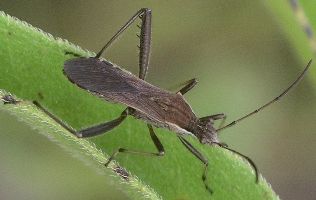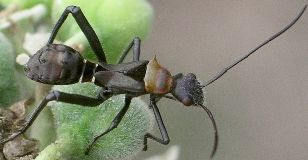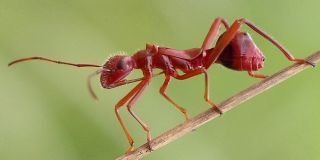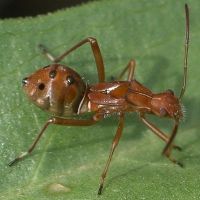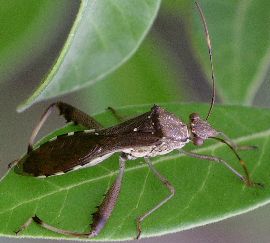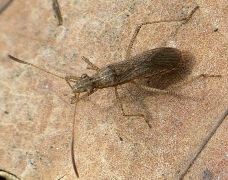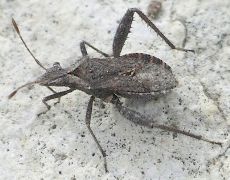
| Alydidae ~ Broad-headed Bugs |
|
Alydidae is a small family of rarely noticed bugs. The species range from about 6-17 mm in length and they are not important plant pests or a nuisance to people. This family is closely related to Coreidae and used to be classified within that group. Broad-headed bugs get their name because their head looks wide compared to the pronotum. There is a constricted "neck" between the head and the body.
The most common species in our area is Hyalymenus tarsatus. This is a wasp mimic, but not a particularly good one from my human vantage point. They have curved hind tibiae, with males having slightly thicker legs than the females. They also have two large white spots on each side of the thorax. These imitate the same markings that occur on some kinds of sphecid wasps and, combined with the slender general body shape, they probably give a predator enough wasp-like signals to make them hesitate. H. tarsatus can often be seen feeding on a variety of plants, especially euphorbias and seed pods of legumes. They will fly when frightened, but more often try to hide by just scooting around a stem or leaf. Another rather common species is Alydus pilosulus, which is a smaller insect than Hyalymenus tarsatus and also tends to be more often found on the ground. It is slightly ant-like in appearance, mainly in movement. This species is dark, sometimes being almost black, and has a hairy texture. There are narrow white lines on each side of the head and thorax.
A species that I have not yet seen in our area is Megalotomus quinquespinosus. I photographed this insect near Dallas, so it might be around here. It is about the same size as Hyalymenus and could be confused with them. However, it has very thin and straight hind tibiae and also has a distinct white ring on the long tip segment of its antennae.
Alydus pilosulus nymphs are also very ant-like but have a few distinguishing marks that set them apart from H. tarsatus. They have dark spots on the abdomen as well as a thin light line down the center of the thorax. Their body is more stout as well.
There is a species in our area that I have not been able to identify. It looks like it is very closely related to Hyalymenus tarsatus, and must certainly be in that genus. It has slightly curved hind tibiae, which are always light-colored with a dark band at the distal end. The sides of the abdomen are marked with very distinctive white and black stripes and the tip segment of the antennae has an indistinct light band. The color of the back is darker than Hyalymenus tarsatus and the sides of the thorax are light, not dark with two white spots.
One alydid does not have the broad head for which the family is named. This is a Stenocoris species and it resembles a large version of a stilt bug or perhaps one of them more slender assassin bugs. This is a green insect, about 15 mm long, with dark markings on the back, reddish knees, and white bands on the antennae. Though not terribly common here, it does show up regularly, often found on flowers. Most references give the range of two Stenocoris species as being the southeastern part of the U.S., but there is also a South American species that has been reported in this country.
There are also two very small species in our area. Esperanza texana sometimes comes to lights and also can be found under logs and around buildings. It is a very slender brown insect and about 6-7 mm in length but has very distinctive long antennae, with a large swollen segment on the tip. These can sometimes be found in groups during the winter, sheltering from the cold.
I've only seen Stachyocnemus apicalis once but it could easily be overlooked. It is gray with a dark triangle on its pronotum, rather wide with short antennae, and about 7 mm in length. The individual I saw was feeding on Dalea and quickly dropped off to hide when disturbed. |
![]()


